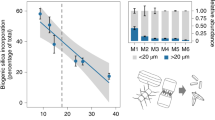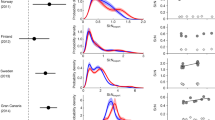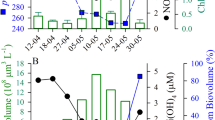Abstract
Diatoms are unicellular or chain-forming phytoplankton that use silicon (Si) in cell wall construction. Their survival during periods of apparent nutrient exhaustion enhances carbon sequestration in frontal regions of the northern North Atlantic. These regions may therefore have a more important role in the ‘biological pump’ than they have previously been attributed1, but how this is achieved is unknown. Diatom growth depends on silicate availability, in addition to nitrate and phosphate2,3, but northern Atlantic waters are richer in nitrate than silicate4. Following the spring stratification, diatoms are the first phytoplankton to bloom2,5. Once silicate is exhausted, diatom blooms subside in a major export event6,7. Here we show that, with nitrate still available for new production, the diatom bloom is prolonged where there is a periodic supply of new silicate: specifically, diatoms thrive by ‘mining’ deep-water silicate brought to the surface by an unstable ocean front. The mechanism we present here is not limited to silicate fertilization; similar mechanisms could support nitrate-, phosphate- or iron-limited frontal regions in oceans elsewhere.
This is a preview of subscription content, access via your institution
Access options
Subscribe to this journal
Receive 51 print issues and online access
$199.00 per year
only $3.90 per issue
Buy this article
- Purchase on Springer Link
- Instant access to full article PDF
Prices may be subject to local taxes which are calculated during checkout




Similar content being viewed by others
References
Lévy, M., Klein, P. & Tréguer, A.-M. Impact of sub-mesoscale physics on production and subduction of phytoplankton in an oligotrophic regime. J. Mar. Res. 59, 535–565 (2001)
Savidge, G., Boyd, P., Pomroy, A., Harbour, D. & Joint, I. Phytoplankton production and biomass estimates in the north-east Atlantic Ocean, May–June 1990. Deep-Sea Res. I 42, 599–617 (1995)
Yallop, M. L. Distribution patterns and biomass estimates of diatoms and autotrophic dinoflagellates in the NE Atlantic during June and July 1996. Deep-Sea Res. II 48, 825–844 (2001)
Koeve, W. Wintertime nutrients in the North Atlantic—New approaches and implications for new production estimates. Mar. Chem. 74, 245–260 (2001)
Ducklow, H. W. & Harris, R. P. Introduction to the JGOFS North-Atlantic Bloom Experiment. Deep-Sea Res. II 40, 1–8 (1993)
Martin-Jezequel, V., Hildebrand, M. & Brzezinski, M. A. Silicon metabolism in diatoms: Implications for growth. J. Phycol. 36, 821–840 (2000)
Honjo, S. & Manganini, S. J. Annual biogenic particle fluxes to the interior of the North Atlantic Ocean studied at 34° N 21° W and 48° N 21° W. Deep-Sea Res. II 40, 587–607 (1993)
Egge, J. K. & Aksnes, D. L. Silicate as regulating nutrient in phytoplankton competition. Mar. Ecol. Prog. Ser. 83, 281–289 (1992)
Sieracki, M. E., Verity, P. G. & Stoecker, D. K. Plankton community response to sequential silicate and nitrate depletion during the 1989 North Atlantic spring bloom. Deep-Sea Res. II 40, 213–225 (1993)
Sverdrup, H. U. On the conditions for the vernal blooming of phytoplankton. J. Cons. Perm. Int. Explor. Mer. 18, 287–295 (1953)
Longhurst, A. R. Ecological Geography of the Sea (Academic, San Diego, 1998)
Dugdale, R. C., Wilkerson, F. P. & Minas, H. J. The role of a silicate pump in driving new production. Deep-Sea Res. I 42, 697–719 (1995)
Yool, A. & Tyrell, T. Role of diatoms in regulating the ocean's silicon cycle. Glob. Biogeochem. Cycles 17, 1103 (2003) (doi:10.1029/2002GB002018)
Lovejoy, C., Legendre, L. & Price, N. M. Prolonged diatom blooms and microbial food web dynamics: experimental results from an Arctic polynya. Aquat. Microb. Ecol. 29, 267–278 (2002)
Dugdale, R. C. & Wilkerson, F. P. Silicate regulation of new production in the equatorial Pacific upwelling. Nature 391, 270–273 (1998)
Brzezinski, M. A., Villareal, T. A. & Lipschultz, F. Silica production and the contribution of diatoms to new and primary production in the central North Pacific. Mar. Ecol. Prog. Ser. 167, 89–104 (1998)
Louanchi, F. & Najjar, R. G. Annual cycles of nutrients and oxygen in the upper layers of the North Atlantic Ocean. Deep-Sea Res. II 48, 2155–2171 (2001)
Allen, J. T., Smeed, D. A. & Chadwick, A. L. Eddies and mixing at the Iceland Faeroes Front. Deep-Sea Res. I 41, 51–79 (1994)
Strass, V. H. Chlorophyll patchiness caused by mesoscale upwelling at fronts. Deep-Sea Res. 39, 75–96 (1992)
Allen, J.T. et al. RRS Discovery Cruise 253, 04 May–20 June 2001. Faeroes–Iceland–Scotland Hydrographic and Environmental Survey (FISHES). Southampton Oceanography Centre Cruise Report No. 37, 1–206 (http://eprints.soton.ac.uk/245/) (2001).
Moore, C. M., Lucas, M. I., Sanders, R. & Davidson, R. Basin-scale variability of phytoplankton bio-optical characteristics in relation to bloom state and community structure in the North East Atlantic. Deep-Sea Res. I 52, 401–419 (2005)
Brown, L., Sanders, R., Savidge, G. & Lucas, C. H. The uptake of silica during the spring bloom in the north east Atlantic ocean. Limnol. Oceanogr. 48, 1831–1845 (2003)
Allen, J. T. & Smeed, D. A. Potential vorticity and vertical velocity at the Iceland Faeroes Front. J. Phys. Oceanogr. 26, 2611–2634 (1996)
Munk, W., Armi, L., Fischer, K. & Zachariasen, F. Spirals on the sea. Proc. R. Soc. Lond. A 456, 1217–1280 (2000)
Fielding, S. et al. Mesoscale subduction at the Almeria–Oran front. Part 2: Biophysical interactions. J. Mar. Syst. 30, 287–304 (2001)
Allen, J. T., Ruiz, S., Smeed, D. A. & Tintoré, J. Mesoscale subduction at the Almeria–Oran front. Part 1: Ageostrophic flow. J. Mar. Syst. 30, 263–285 (2001)
Naveira-Garabato, A. C., Strass, V. H. & Kattner, G. Fluxes of nutrients in a three-dimensional meander structure of the Antarctic Polar Front. Deep-Sea Res. II 49, 3771–3792 (2002)
Shearman, R. K., Barth, J. A. & Kosro, P. M. Diagnosis of the three-dimensional circulation associated with mesoscale motion in the California Current. J. Phys. Oceanogr. 29, 651–670 (1999)
Brzezinski, M. A. & Phillips, D. A. Evaluation of 32Si as a tracer for measuring silica production rates in marine waters. Limnol. Oceanogr. 42, 856–865 (1997)
Allen, J., Dunning, J., Cornell, V., Moore, M. & Crisp, N. Operational oceanography using the ‘new’ SeaSoar ocean undulator. Sea Technol. 43, 35–40 (2002)
Acknowledgements
FISHES was a multidisciplinary experiment conducted as part of the Biophysical Interactions and Controls on Export Production core strategic programme. We thank R. Pollard for initiating and developing the FISHES experiment, which fully met its objectives owing to the enthusiasm and professionalism of all the officers, crew and scientists of RRS Discovery cruise 253. We thank the Defence Evaluation and Research Agency (now the Defence Science and Technology Laboratory) for their support of a number of staff involved in FISHES through the development of the Techniques for Optimising Environmental Sampling Joint Grant Scheme project. We thank the Natural Environment Research Council for their support of the George Deacon Division, and the National Oceanography Centre for their commitment to core strategic science funding.
Author information
Authors and Affiliations
Corresponding author
Ethics declarations
Competing interests
Reprints and permissions information is available at npg.nature.com/reprintsandpermissions. The authors declare no competing financial interests.
Rights and permissions
About this article
Cite this article
Allen, J., Brown, L., Sanders, R. et al. Diatom carbon export enhanced by silicate upwelling in the northeast Atlantic. Nature 437, 728–732 (2005). https://doi.org/10.1038/nature03948
Received:
Accepted:
Issue Date:
DOI: https://doi.org/10.1038/nature03948
This article is cited by
-
Improved seasonal prediction of harmful algal blooms in Lake Erie using large-scale climate indices
Communications Earth & Environment (2022)
-
Climate variability and multi-decadal diatom abundance in the Northeast Atlantic
Communications Earth & Environment (2022)
-
Evidence of the Significant Contribution of Heterotrophic Diazotrophs to Nitrogen Fixation in the Eastern Indian Ocean During Pre-Southwest Monsoon Period
Ecosystems (2022)
-
Photosynthesis acclimation under severely fluctuating light conditions allows faster growth of diatoms compared with dinoflagellates
BMC Plant Biology (2021)
-
Chlorophyll fluorescence as a light signal enhances iron uptake by the marine diatom Phaeodactylum tricornutum under high-cell density conditions
BMC Biology (2021)
Comments
By submitting a comment you agree to abide by our Terms and Community Guidelines. If you find something abusive or that does not comply with our terms or guidelines please flag it as inappropriate.



